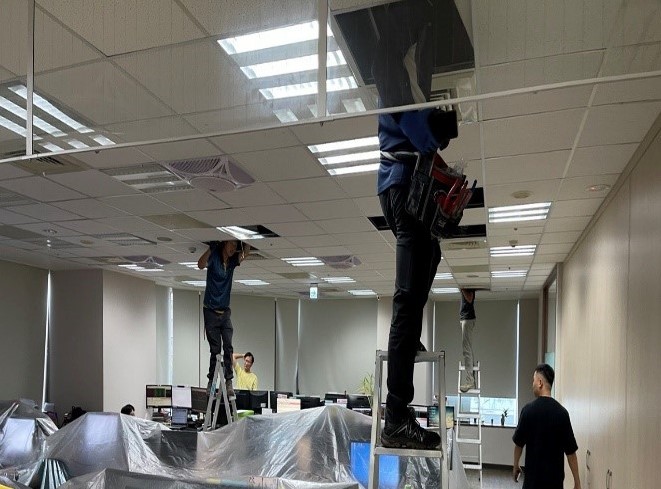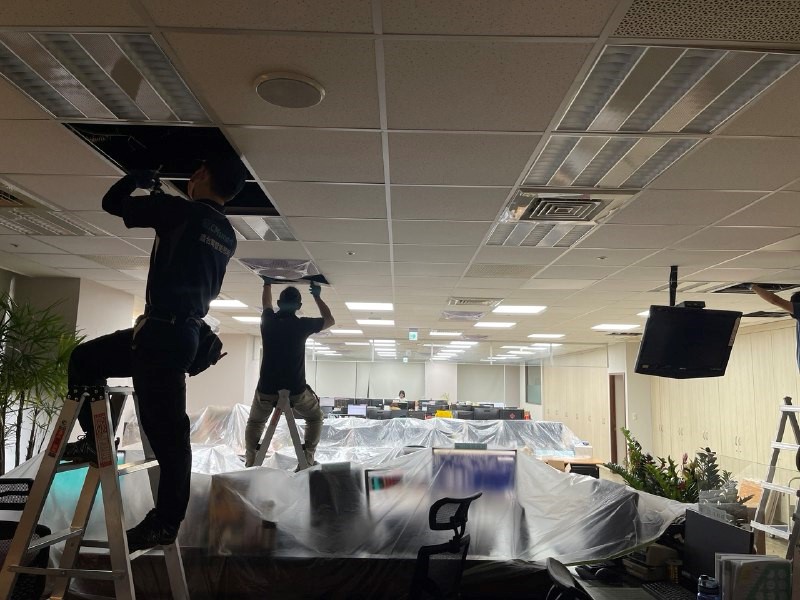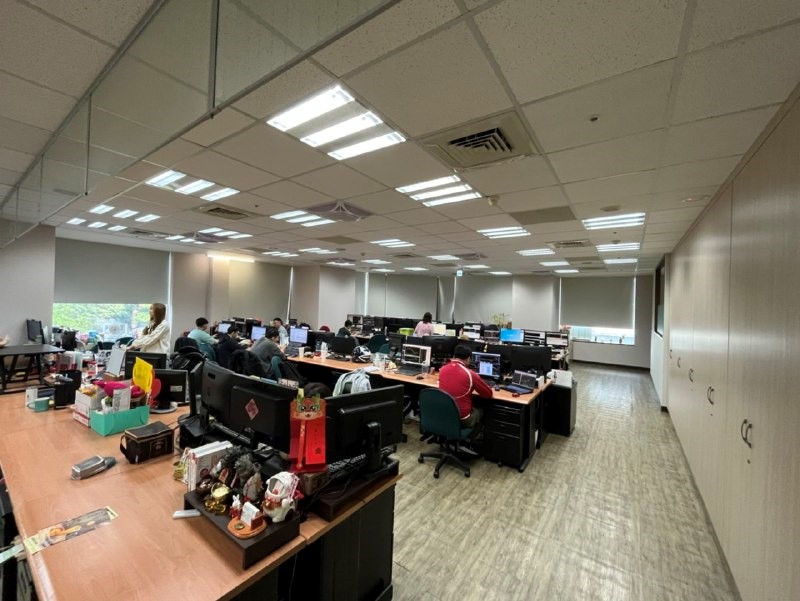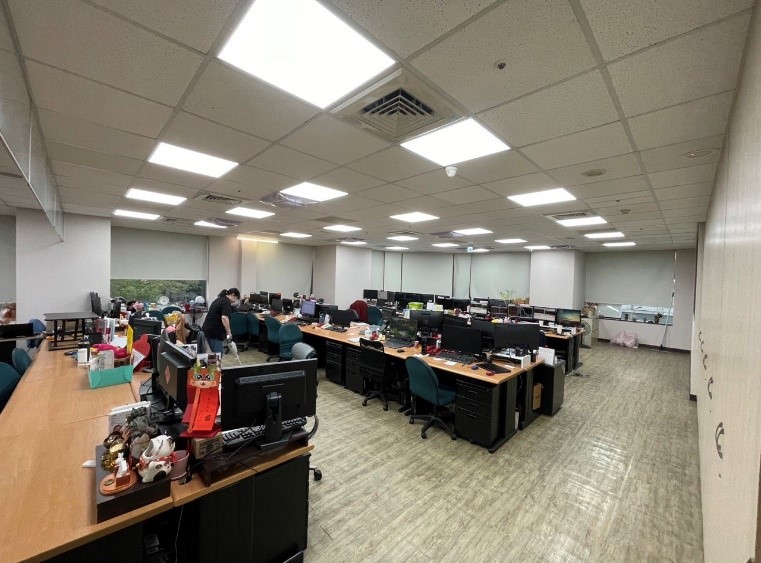Energy-saving and carbon reduction measures and results
Our company is in the financial services industry, with overall direct material consumption and carbon emissions relatively lower compared to other industries. We do not produce or sell physical products, nor do we use, transport raw materials or recycled materials. We also do not have issues with product and packaging recycling. The environmental impact of our operations is relatively small. Our company interacts closely with the public, upholding the concept of loving the earth, and actively responding to and implementing energy-saving, carbon reduction, and ecological conservation activities. Aiming to gradually realize a green workplace environment, we are committed to improving energy efficiency and reducing the consumption of paper, water resources, and various forms of energy through various actions and improvement measures.
With the rapid advancement of technology, information services are boundless and can transcend time and space limitations. To meet the demand for more convenient and faster services, our company is actively promoting e-services, striving to make financial services more accessible to everyone. On our company website, we provide the latest domestic and international economic and financial situations and indicators, market information, and commentary, expanding applicability to various mobile devices.
We are deeply aware that the Earth's climate and environment are continuously deteriorating due to the impact of greenhouse gases. As a responsible corporate citizen and part of the global community, Capital Futures recognizes the need to fulfill its corporate social responsibility and comply with international regulations such as the United Nations Framework Convention on Climate Change and the Paris Agreement. Accordingly, we are committed to conducting a comprehensive inventory of the company's greenhouse gas emissions to effectively monitor and manage the current state of emissions and, based on the results, implement voluntary greenhouse gas reduction initiatives.
To fulfill our environmental protection responsibilities and support the national net-zero emissions policy, we proactively carry out greenhouse gas inventories and verifications to identify and address activities with significant impacts. We are formulating energy-saving and carbon reduction strategies and action plans, rigorously supervising their implementation, and continuously promoting measures to reduce greenhouse gas emissions. Additionally, we actively evaluate and adopt renewable energy solutions.
"Our company actively promotes waste management, focusing on source reduction and resource recycling to minimize the environmental impact of waste. As a financial services provider, the primary type of waste we generate is household waste. We implement waste classification and reduction strategies by categorizing waste into general waste and recyclable materials. General waste is handled by the building's property management company or certified cleaning service providers, while recyclable materials are managed by professional recycling firms to ensure compliance with relevant regulations and environmental standards. Additionally, the company fosters recycling and waste reduction among employees through awareness campaigns and incentive programs, thereby achieving an indirect reduction in greenhouse gas emissions. In procurement, we prioritize products that meet environmental and energy-saving standards, continuously improving the resource efficiency of office and electrical equipment to ensure our operations align with environmental protection and energy-saving objectives."
As a service-oriented financial institution, our company is not a water-intensive industry. However, we are deeply aware of the impact of water scarcity on the global economy and society and embrace our environmental responsibilities. We are committed to promoting water resource management by incorporating water conservation and efficiency improvements into our management guidelines. Measures such as replacing high-water-consumption equipment and selecting water-saving certified products are implemented to continuously optimize internal water-use systems and processes, ensuring efficient resource utilization. In addition, through employee education and awareness campaigns, we aim to enhance understanding of water resource issues and encourage the integration of water-saving practices into work and daily life, fostering a sustainable water-use culture. We believe these efforts not only support our operations but also contribute to the sustainable use of water resources and the advancement of society.
The Company has designated 2023, the year in which third-party assurance for its greenhouse gas (GHG) inventory was obtained, as the baseline year, and has set short-term (2026), medium-term (2029), and long-term (2030) targets as follows:
| Goals | Short-term (2026) | Medium-term (2029) | Long-term (2030) |
|---|---|---|---|
| Greenhouse Gas Emissions | 3% reduction compared to the baseline year | 5% reduction compared to the baseline year | 10% reduction compared to the baseline year |
| ※Scope 1 and Scope 2, measured as emissions intensity in metric tons of CO₂e per million in revenue | |||
| Waste Reduction | 3% reduction compared to the baseline year | 5% reduction compared to the baseline year | 10% reduction compared to the baseline year |
| Water Resource Management | 1% reduction compared to the baseline year | 3% reduction compared to the baseline year | 5% reduction compared to the baseline year |
| ※Measured on a per capita basis | |||
Capital Futures will review the achievement of targets and make rolling adjustments based on external environmental trends. We aim to mitigate the impact of climate change through these target management measures and maintain stable and normal operations.
In 2024, the company procured a total of 93 computer mainframes and 45 computer monitors, with a total expenditure of 1,981,732. All products were certified with eco-labels, showcasing the company's active efforts in promoting green procurement and environmental protection.
This procurement adheres to the company's sustainable development policy, prioritizing equipment that meets energy efficiency and environmental standards. By implementing such procurement strategies, the company not only effectively reduces carbon emissions but also demonstrates its commitment to a sustainable future.
In recent years, our company's operational scale has been continuously expanding, and the number of employees has been steadily increasing. However, through effective energy-saving and carbon reduction measures, the overall consumption of direct materials, water, electricity, and carbon emissions have been effectively controlled. The main operational needs of the company include procurement and maintenance of information equipment, construction and renovation projects, procurement of materials related to operational business facilities, and building operations and maintenance. To implement green procurement, we prioritize local suppliers in Taiwan and at our operational locations, ensuring supply chain stability and localization, thereby promoting local economic development. We comprehensively promote e-energy saving, waste reduction, and resource recycling and reuse, changing colleagues' daily operations to instill environmental awareness.
- The office environment is designed with simplicity and practicality in mind, following a lightweight decoration principle. Building materials are chosen primarily for their environmental certification to reduce harmful air pollutants.
- Partitions, desks, and filing cabinets are all designed to be disassembled and reassembled, allowing for recycling and reuse to avoid resource waste.
- Office lighting mainly uses energy-saving fixtures and anti-glare lamps or grilles to enhance indoor lighting efficiency.
- Implement office lighting control by zones, and turn off unnecessary lights promptly.
- Install small air conditioning units to replace large units during off-peak times.
- Regularly have contractors clean and maintain the air conditioning systems to improve cooling efficiency and extend the lifespan of the equipment.
- Enhance the promotion of water-saving measures and cherish water resources.
- Water dispensers are controlled by a time switch and are turned off after work hours or on holidays.
- Outsourced vendors regularly inspect and maintain water dispensers to ensure the safety of daily drinking water.
- Designate recycling areas in each office location to sort and recycle outdated information equipment, light tubes, toner cartridges, and other office supplies.
In July 2023, the company launched a lighting efficiency upgrade project at the Taipei headquarters. A total of 97 fixtures were replaced in specific areas, upgrading from the original T5-14W*4 tube lamps (56W per fixture) to 38W LED panel lights. The investment amounted to NT$121,250. Initial estimates indicate that this initiative could save approximately 4,148 kWh of electricity annually (assuming 9 hours of daily usage), reducing carbon emissions by about 2,053.26 kgCO2e per year.
In May 2024, the project was further expanded to the 3rd floor of the Taichung branch. All office area lighting fixtures were replaced with LED lights to enhance energy efficiency and reduce carbon emissions.
The investment in this phase amounted to NT$76,230, involving the replacement of 90 fixtures in specific areas. The original T5-14W*4 tube lamps (56W per fixture) were replaced with 32W LED panel lights. Initial estimates suggest an annual savings of approximately 5,132 kWh of electricity (assuming 9 hours of daily usage), reducing carbon emissions by about 2,530.762 kgCO2e per year.
| Type of Lighting Fixture | T5-14W*4 Fluorescent Tubes | LED Flat-Panel Lights | ||||||||
|---|---|---|---|---|---|---|---|---|---|---|
| Wattage | 56W | 32W | ||||||||
| Appearance of Lighting Fixture |
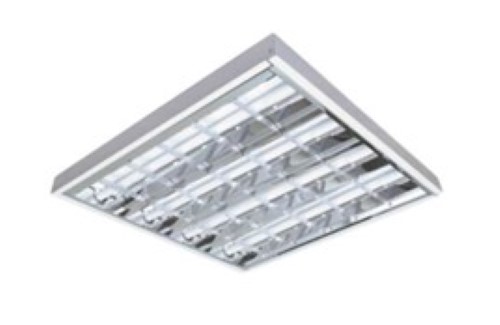
|
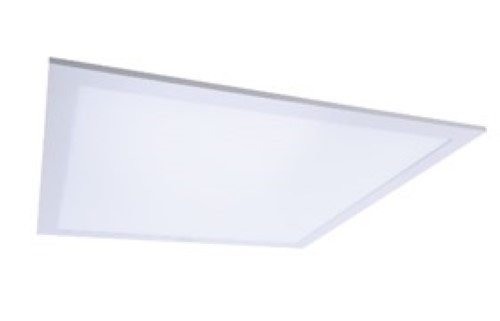
|
||||||||
| Energy Savings (Calculation Formula Reference) |
24W * 90 lamps * 9 (hours) * 22 (workdays) * 12 (months) / 1000 = 5,132.16 | |||||||||
| Carbon Reduction Data (Calculation Formula Reference) |
5,132 kWh * 0.494 kgCO2e/kWh = 2,530.762 | |||||||||
|
Implementation Status (Photo) |
|
|||||||||
In March 2024, the company implemented a photocopier carbon reduction replacement project, replacing some toner-based photocopiers with inkjet photocopiers.
Compared to laser photocopiers, inkjet machines eliminate high-energy-consuming processes such as repeated high-temperature heating and "exposure." By simplifying the process, they not only enhance operational efficiency but also significantly reduce overall electricity consumption.
Preliminary estimates suggest that this initiative can save approximately 2,900 kWh of electricity annually, reducing carbon emissions by about 1.4355 metric tons of CO2e per year.
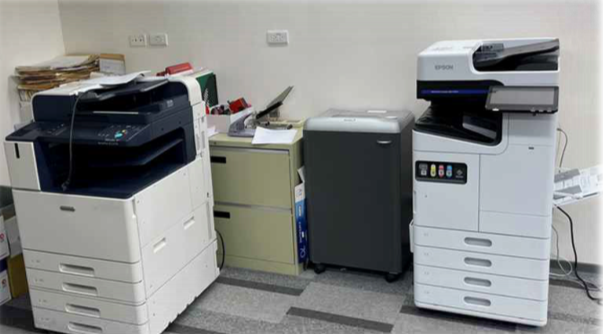
To reduce environmental impact and enhance corporate energy efficiency and carbon reduction, while aligning with environmental protection and sustainable development goals, the company replaced outdated chiller units using R22 refrigerant with high-efficiency, energy-saving equipment using R410 refrigerant from June to August 2024. The total investment for the equipment upgrade amounted to 3,074,400.
R410 refrigerant is free of chlorine and causes zero damage to the ozone layer, effectively reducing its negative environmental impact. Additionally, the new chiller units incorporate advanced technology, significantly improving operational efficiency, lowering energy consumption, and greatly reducing electricity usage, thereby achieving energy-saving outcomes.
Following the equipment upgrade, overall carbon emissions during operation have further decreased, aiding the company in meeting its carbon reduction targets. This aligns with international carbon reduction trends and related regulations, fully demonstrating the company's commitment to green sustainability.
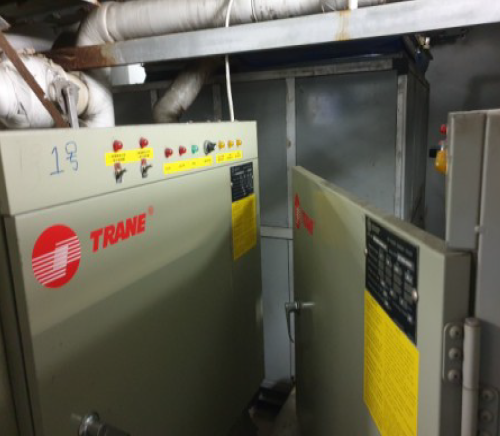
|
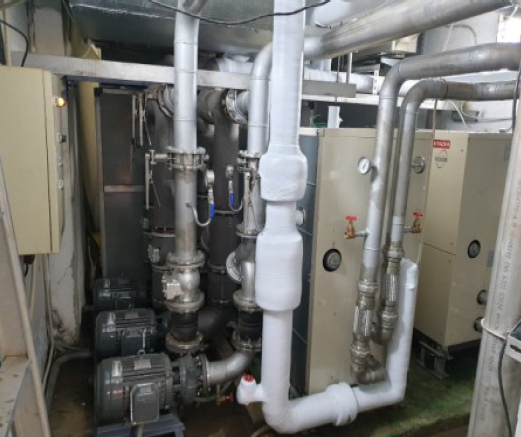
|
| Old Air Conditioning System | New Air Conditioning System |
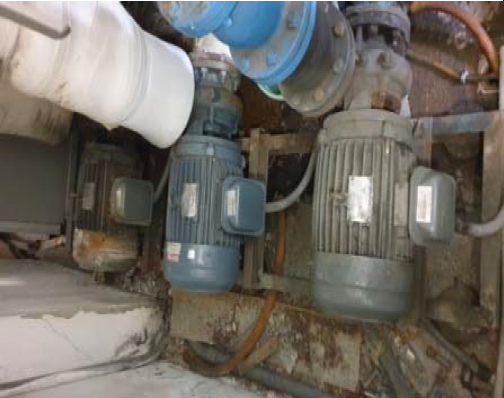
|
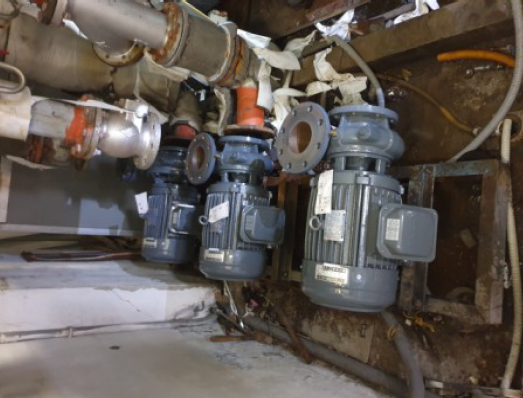
|
| Old Motor | New Motor |
| Issue | Indicator | Unit | 2024 | 2023 |
|---|---|---|---|---|
| Greenhouse Gas Emissions | Direct Greenhouse Gas Emissions (Scope 1) | Metric Tons CO2e | 42.4096 | 36.4715 |
| Energy Indirect (Scope 2) | Metric Tons CO2e | 553.9201 | 508.6562 | |
| Other Indirect (Scope 3) | Metric Tons CO2e | 2.2066 | 1.7330 | |
| Greenhouse Gas Emission Intensity | tCO2e / Million Revenue | 0.2471 | 0.2722 | |
| Water Resource Management | Water Consumption | Metric Tons | 5,245.18 | 5,544.16 |
| Water Intensity | Metric Tons / Million Revenue | 2.1737 | 2.7679 | |
| Waste Management | Hazardous Waste | Metric Tons | 0 | 0 |
| Non-Hazardous Waste | Metric Tons | 6.4900 | 5.0969 | |
| Total Weight | Metric Tons | 6.4900 | 5.0969 | |
| Waste Intensity | Metric Tons / Million Revenue | 0.0027 | 0.0025 |
Note 1: Disclosure Scope: All operating sites in Taiwan.
Note 2: The company's greenhouse gas inventory data (Scope 1 and Scope 2) has been verified and obtained a limited assurance report issued by KPMG.
Note 3: The carbon emission factors for electricity under Scope 2 are based on the annual coefficients published by the Bureau of Energy, Ministry of Economic Affairs.
Note 4: The greenhouse gas emission intensity is calculated by using the sum of Scope 1 and Scope 2 values divided by revenue in millions.
Note 5: Scope 3 emissions are disclosed only for general waste.

